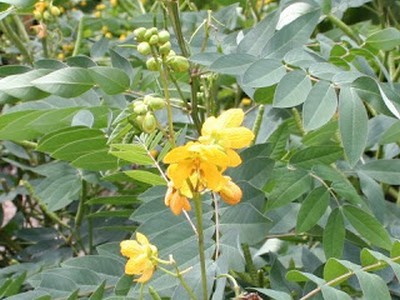
Common Name: Kasundi,Kasamarda
English Name: The Negro Coffee, Coffee senna, Stinking Weed
Botanical Name: Cassia occidentalis Linn.
Family: Caesalpiniaceae
Description: Erect herb, 0.15-2 m high; stems subglabrous. Leaves paripinnate; petioles with a large sessile gland; rhachis without glands; leaflets in 4-5 pairs, ovate to ovate-elliptic or lanceolate, 5-12 cm long, 2-4 cm wide, acute or acuminate at apex, glabrous with ciliolate margins and inconspicuous scattered glands beneath. Inflorescence racemes from upper axils, very short, almost umbellate; petals yellow.
Chemical Constituents: The chemical constituents isolated from Cassia occidentalis leaves are alkaloids, flavonoids, tannins, phlobatannins, chrysophanol, emodin, physcion, tetrahydroanthracene, derivative, germichrysone, occidentalins A and B. Seeds are found to contain galactomannan gum, tannic acid, oils, amodiene, toxalbumin and crisarobin.
Properties: Roots, leaves and seeds are used for fever, menstrual problems, liver ailments. This plant is also used to cure sore eyes. The seeds are brewed into a coffee like beverage for asthma, malaria, fevers and stomach complaint. Aqueous extract of Cassia occidentalis exhibited significant antihyperglycemic activity. Leaves, bark and seeds are used in the treatment of diabetes, inflammation, ulcers and leprosy. It is bitter, sweet and also used as a purgative.
Used in the following MATXIN product: